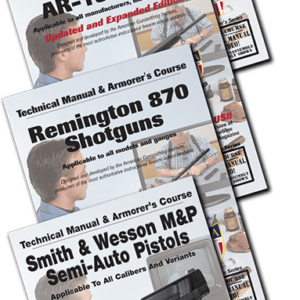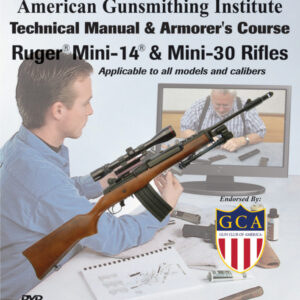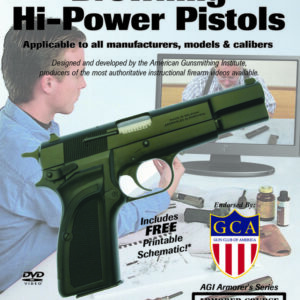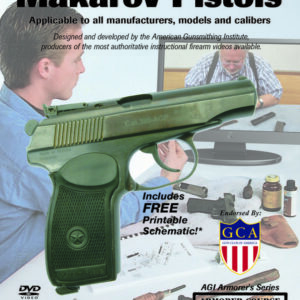Description
Covers Smith & Wesson 1st, 2nd, and 3rd Generation Auto Pistols
Bob Dunlap is a renowned expert on many firearms, including the Smith & Wesson Auto-Pistols. This video covers the First, Second, and Third Generations of these very popular guns. This course does NOT cover the later model Sigma and M&P guns. Bob uses a cut away gun so that you can actually see how the internal parts function and their relationship to one another.
If you want the quick course on how to get these guns apart, back together, and operating as intended, then this course is for you (if you want the “long course,” look into our basic 108 hour Professional Gunsmith Course.)
Among the items covered are:
History
- The Model 39 was the first of the Smith & Wesson auto pistols to hit the market, this occurred in the mid-1950s. These were, along with the Walther PP/PPK/P-38 guns, the first successful DA Semi Auto pistols to reach the market
- Next to arrive was the Model 59, which added Hi-Cap magazines to the mix
- Both the 39, 59 and the Second Gen guns had safety notches in the hammer, the later guns did not
- The Second Gen guns came out in the late 1970s and proved very popular with the law enforcement market, leading the charge away from revolvers to the latest and greatest wonder Nine du jour. This, coincidentally, also led the charge away from marksmanship and to firepower
- The Third Gen guns came along in the late 1980s and were a marked improvements
- Third Gen guns also felt the best
Design & Function
- Explanation and demonstration of the short recoil, tipping barrel, locked breech operating system
- One of the first pistols to use the breech end of the barrel as a locking lug
- Bob shows the answer to the question; what causes the barrel and slide to lock and unlock and how does it do it?
- How the magazine safety/disconnector/ejector depressor system operates
- Firing/loading/unloading cycle explained and demonstrated
- Does the extractor really extract
- How to know that the extractor is NOT fulfilling its primary function
- First Gen and early Second Gen extractors described
- How the trigger drawbar cocks and lets the hammer fall
- How the sear depressor/safety/de-cocker/firing pin block works
- Explanation and demonstration of the trigger actuated firing pin blocking safety
- Lower end taken apart and the details of the individual fire control parts shown and their inter-relationship described
- What surfaces to keep your pistol smoothing efforts away from
- What four parts cause the disconnector to do its job
- How the hammer drop/safety blocks the firing pin
- Operation of the magazine catch shown
- How the slide stop works, and how it works with the magazine empty
- What to avoid if you dont want to hear silence instead of bang with the Model 39
Disassembly
- Pay attention to the parts orientation while disassembling, a digital camera is very helpful to take pictures of the parts before you remove them
- Extensive disassembly, variances between different models and generations described parts not removed have removal described, i.e., the trigger pin detent plunger and the hammer strut
- Slide stop pin removal procedure difference between the S&Ws and the 1911
- Three different styles of right side ambi-safety retaining systems shown
- See a clever, cheap, and simple tool you can make to make the magazine catch removal easier
Cleaning & Lubrication
- AGI cleaning & lubrication methods shown, along with the reasons for their use
- After cleaning, dry with air gun, a hair dryer, or in the oven on Warm ~185-200 degrees (metal parts ONLY)
- What oil Bob likes to lube the gun with during assembly
Reassembly
- Making sure you have no parts left over
- Getting the right springs in the right place
- In many cases the order of assembly is important, Bob shows you the correct order
- Getting the right pieces in the right places, the easiest way possible
- Using the proper tool to help you line up the parts to accept their pins
- Multiple models differences are discussed and, in many cases, demonstrated
- How to make sure that the extractor is doing its job
- What is moment of mass
- Proper shape of extractor hook
- How to make sure you have tight sights
- Fixing the firing pin so that it does not pierce primers or shave brass on extraction
- Stay away from the trigger drawbar notches if you get the irresistible urge to improve the trigger pull, it is cheaper to send the gun to someone who knows what they are doing than to buy a new drawbar
- Improving feeding
Accessories
- Because of the wide variation of configuration in the various models, aftermarket accessory manufacturers have a fit problem
- What is useful
- What to avoid and why, springs and things
- LATE MENTION What to look for on a Third Gen one piece grip, and who will replace it if its missing its mark
Final Thoughts
If you noticed how often the terms explanation and visual demonstration are used, you may be getting some idea of why this course is necessary for any Smith & Wesson semi-auto owner, or someone who intends to be.




